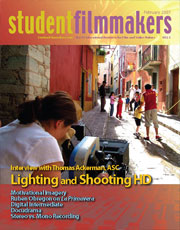HOW-TO, Techniques, & Best Practices Channel
| Using Documentary Techniques to Craft Stories By Dana Dorrity posted Nov 3, 2009, 20:30 |
Check out this article in the print edition of StudentFilmmakers Magazine, February 2007. Click here to get a copy and to subscribe >>
 Using
Documentary Techniques to Craft Stories
Using
Documentary Techniques to Craft Stories
A Look into 'United 93', 'Bloody Sunday', 'The Road to Guantanamo',
and Other Films
by Dana Dorrity
In the Communications program where I teach, documentary production is a foundation
course. Students learn ENG style production in their first year and begin work
on thirty-minute documentaries as sophomores. We believe that students challenged
to conduct research, shoot interviews, and edit long form documentary projects
will be much better prepared to become television journalists and narrative
filmmakers. We also think there are expanding opportunities in documentary-style
production both on television and in feature film.
 Many
contemporary filmmakers are borrowing techniques from documentary to craft fictional
stories. Paul Greengrass, the director of United 93, has built his
career crafting true stories into emotional, compelling feature films. His films
are not documentaries, but rather they are elaborate, dramatic reconstructions
that often employ some of the real participants in the events to play themselves
in the movie. In what is probably the most compelling performance in United
93, Ben Sliney, the chief of the FAA’s air traffic control center,
reenacts the events that led him to his decision to close the skies. September
11th, 2001, just happened to be Sliney’s first day on the job. Although
Greengrass has also directed action films like The Bourne Supremacy,
he developed his non-fiction dramatic recreation techniques working on his 2002
film, Bloody Sunday, about the 1972 massacre of protestors in Northern
Ireland. As Gillo Pontecorvo depicted the inner workings of terrorist cells
in Algeria in The Battle of Algiers, Bloody Sunday shows the
roots of insurgency in an occupied territory. It should be required viewing
for all of us who are trying to make sense of the war in Iraq and the endless
conflict in Israel.
Many
contemporary filmmakers are borrowing techniques from documentary to craft fictional
stories. Paul Greengrass, the director of United 93, has built his
career crafting true stories into emotional, compelling feature films. His films
are not documentaries, but rather they are elaborate, dramatic reconstructions
that often employ some of the real participants in the events to play themselves
in the movie. In what is probably the most compelling performance in United
93, Ben Sliney, the chief of the FAA’s air traffic control center,
reenacts the events that led him to his decision to close the skies. September
11th, 2001, just happened to be Sliney’s first day on the job. Although
Greengrass has also directed action films like The Bourne Supremacy,
he developed his non-fiction dramatic recreation techniques working on his 2002
film, Bloody Sunday, about the 1972 massacre of protestors in Northern
Ireland. As Gillo Pontecorvo depicted the inner workings of terrorist cells
in Algeria in The Battle of Algiers, Bloody Sunday shows the
roots of insurgency in an occupied territory. It should be required viewing
for all of us who are trying to make sense of the war in Iraq and the endless
conflict in Israel.
 |
 |
There’s nothing new about using documentary techniques in fictional
films. Bob Fosse’s classic Biopic, Lenny, intercut interviews with the
characters into the story. Reds, Warren Beatty’s 1981 biographical epic
about John Reed, used interviews with American communists who lived through
this turbulent period to reinforce the dramatic scenes between Beatty, Diane
Keaton and Jack Nicholson. Woody Allen used a hand-held and cinéma vérité
style for his film Husbands and Wives about the dissolution of one
marriage and strength of another. Although Orson Welles’ Citizen Kane
followed a reporter’s search for the meaning of the main character’s
last word and uses a fake news reel to set up the story, it uses a more traditional
feature film technique and never breaks the third wall. Characters speak to
each other rather than directly to camera as they do in documentary-style films.
In television, documentary may seem to have been supplanted by reality TV, but
there are documentary style programs on nearly every channel from MTV to Court
TV and A&E. Shows like Flip This House, that follow investors through
the process of renovating dilapidated or outdated houses use cinéma vérité
and interview techniques that are derived directly from documentary filmmaking.
Another director working on the razor’s edge between documentary and narrative
film is Michael Winterbottom. His 2002 film, 24 Hour Party People,
chronicled the life of TV Show host and music promoter Tony Wilson and the rise
of the Manchester music scene. Wilson, played by Steve Coogan, discovered Joy
Division and Happy Mondays and was one of the founders of Factory Records. Because
he’s a television host, it’s natural for his character to talk directly
to a camera, and this film is filled with asides when Wilson turns to camera
and speaks directly to the viewer about the choices he made and even the director’s
decision to skip ahead in his life story or blend a few characters together.
Although the film uses some archival footage, most memorably, scenes of The
Sex Pistols playing in a nearly empty dance hall in Manchester, the archival
footage is seamlessly edited with scenes of the actors which places them at
these historical points. Other concert scenes, specifically the scenes of Ian
Curtis in Joy Division, were created with the actors for the movie.
Winterbottom’s 2006 film, The Road to Guantanamo, is more of
a traditional documentary film. The story is structured around interviews with
three young men who traveled from Britain to Pakistan, then on to Afghanistan,
in the fall of 2001. They were eventually captured as enemy combatants and spent
three years at the Guantanamo prison in Cuba. Winterbottom employed actors to
recreate the scenes of the young men’s journey into Afghanistan and their
terrifying experiences in the American prison camp. The dramatic scenes are
punctuated with a newscaster’s voice and new footage that periodically
links them to the events following the September 11th attack and the invasion
of Afghanistan by US troops. The scenes of torture and their cruel treatment
are shocking, but what is almost equally shocking is the calm and reasoned demeanor
of the Tipton Three in their interviews. Two of the men consider that they are
better people for having survived the detainment in Guantanamo, and the third
says that what didn’t kill him made him stronger. It’s a testament
to the resilience of the human spirit that people cannot only survive but learn
from such an agonizing experience.
What’s interesting in comparing these kinds of films, United 93
and Bloody Sunday, which fictionalize true incidents using documentary
techniques, and The Road to Guantanamo, which uses narrative filmmaking
to dramatize a documentary film, is that the fictional films seem truer. In
The Road to Guantanamo, the viewer is always aware that this is the
reenactment of three men’s stories, and these men, though they were only
seventeen when they were originally arrested, are never able to explain why
they traveled to Afghanistan at such a critical moment in history. United
93 and Bloody Sunday, which are scripted based on historical documents
and oral histories, seem more objectively real. Though there are moments, particularly
at the climax when the passengers decide to crash the plan, when the filmmaker
had to imagine what might have happened, his depiction is such a perfect climax
of the events that it’s hard to believe that anything else could have
happened.
The greatest lesson that students can learn from documentary filmmaking and
particularly the structuring of story that I call documentary screenwriting
is how to craft the climax. The climax of a movie needs to tie together all
the elements of the story in a meaningful way, but life doesn’t usually
work out that way. In life, innocent people may be arrested, detained, tortured
and even killed, and these acts may seem random. Amazingly, Winterbottom is
able to create a meaningful climax to the true stories in The Road to Guantanamo,
and this is what makes the movie worth seeing. When students learn to craft
true stories in meaningful ways, they are well-equipped to eventually write
and direct both documentary and narrative features.
Photos Courtesy of Universal Studios Home Entertainment.
This article may not be reprinted in print or internet publications without express permission of StudentFilmmakers.com. Photos may not be copied or reproduced.
Check out this article in the February 2007 print edition of StudentFilmmakers magazine, page 16. Click here to get a copy of the February 2007 Edition, so you can read and enjoy all of the excellent articles inside.
About the Author:
 Dana Dorrity is an assistant professor of Communications and Media Arts
at Dutchess Community College. She has an MFA in screenwriting from the American
Film Institute and teaches media writing, screenwriting and video production
classes.
Dana Dorrity is an assistant professor of Communications and Media Arts
at Dutchess Community College. She has an MFA in screenwriting from the American
Film Institute and teaches media writing, screenwriting and video production
classes.
Resources:
About StudentFilmmakers Magazine & StudentFilmmakers.com >>
Join the Film and Digital Networking Community >>
Post Your Films, Videos, Reels, and Trailers >>
Discuss Motion Picture Techniques in the Online Industry Forums >>
Get the StudentFilmmakers.com E-Newsletter >>
StudentFilmmakers magazine would like to hear from you!
Click here to
share your comments and feedback about the magazine, monthly editions, your
favorite articles, and your favorite topics.
We always welcome and appreciate your Reader Comments. View them here, and send yours to the editorial team today!